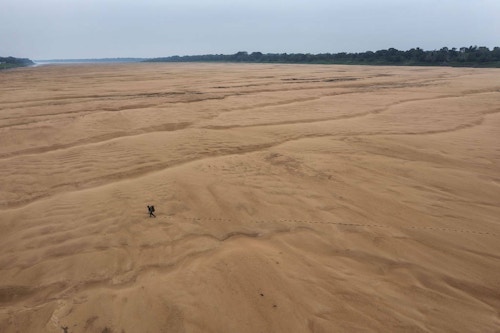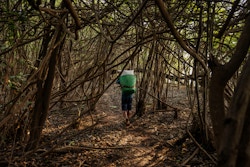
A river turned desert
For the second year in a row, indigenous fishermen watch in despair as their livelihoods disappear with drying riverbeds.
Part of the series:
CLIMATE CHANGE IN THE AMAZON
Text and photo: Vinicius Sassine and Lalo de Almeida
PORTO PRAIA, SEPTEMBER 2024:
"We are isolated."
Onisson Gonçalves walks across the sandbanks. In 2023, he was forced to sell his fishing equipment when a record drought left him - and many other fishermen - without a livelihood. A year later, he watches history repeat itself.
In the community of Terra Indígena Porto Praia de Baixo, in the Tefé region (AM), 32-year-old Gonçalves is known as a man with luck on his side. The Kokama Indigenous father of three is described as one of the best fishers of scale-less fish like surubim, caparari, and dourada in the Solimões River— which flows past Porto Praia—and the lakes connected to it.
About the series:
In the fall of 2024, Rainforest Foundation Norway sent investigative journalist Vinicius Sassine and award-winning photographer Lalo de Almeida to document the human and environmental costs of climate change in the Amazon Rainforest.
The stories were originally published by Brazil's largest broadsheet newspaper, Folha de São Paulo.
He used to fish a lot, all day long, on his own. His technique, the dragnet, and his luck used to ensure an abundance in his work. But during 2023 and 2024's extreme droughts, his fate, and the fate of more than a hundred families in the territory, changed dramatically.
This section of the Solimões river by Porto Praia turned into a desert.

Riverine people cross the dry bed of a branch of the Solimões River by the indigenous community of Porto Praia, in Tefé (AM), to fish in a lagoon that so far has withstood the severe drought affecting the region. - Lalo de Almeida/Folhapress.
With support from Rainforest Foundation Norway, Folha visited this area in 2023, documenting how the drought paralyzes an entire community.
Returning in 2024, Local Indigenous people say the crisis is even more severe this year. The drought started a month earlier and forced small boats to be anchored at an even greater distance from the village's small port—3 km, compared to 2 km last year.
"Now, fish dissapear because the river dries up quickly. Fish can't leave the lakes to spawn."
The river's disappearance marked the end of extensive fishing for the so-called scale-less fish. Few are willing or able to navigate around islands on the other side of the formed sandbanks to continue their journey to lakes, ponds, and river sections where there are still fish to be found.

Map of the area.
Economic Struggles and Resilience
Income from selling these fish provided a comfortable livelihood until the end of the year. Families could earn up to R$ 6,000, enough to cover expenses until the flood season began.
With the river's disappearance, Kokama, Tikuna, and Mayoruna Indigenous people, including Onisson, sold their fishing gear. "I sold my dragnet gear last year," he says, continuing to fish for scale-less fish in the channel behind the islands, now using borrowed gear. I think I'll manage to fish well."
During their visit to Porto Praia in October 2023, Folha captured Onisson’s return to his home after fishing in a lake beyond the sandbanks.
The photo taken by a drone shows the fisherman's footprints in the sand, resembling a desert, despite being taken in one of the Amazon River's main sections in the world’s largest tropical rainforest, a biome notably humid and rainy. Onisson carried a basket on his back—called a paneiro—filled halfway with fish.

Fisherman Onisson Gonçalves crossing the dry bed of the Solimões River, near the indigenous community of Porto Praia, in a photo from 2023. Lalo de Almeida
The photo symbolizes the scale of the ongoing climate crisis and its effects on traditional communities living in the Amazon. It won the regional (South America) award in the "single photo" category of the World Press Photo, the world's most prestigious photojournalism award.
Desperate Circumstances
In Porto Praia, the consequences of extreme drought are evident. According to the community, the reality from 2023 onward does not compare to previous years. The river's disappearance profoundly impacted their way of life, unsettling families and extending travel distances over mud and roads.

An endless cycle of extreme droughts following one another, with no respite, arriving earlier each time.

Fish can't move between lakes and rivers. The population plummets.
"Before, we managed reasonably well [during the dry period]. From 2023 onward, it got complicated, even more so this year, in higher parts," Onisson explains.
"Both sides of the river are closed because of the low water level."
An environment changing before their eyes
The dry landscape, with sandbanks forming in sections of the Solimões River, is a recurring feature within the Amazon’s characteristic dry and rainy cycles. What has changed is the extreme nature, with prolonged droughts, fewer ponds, and less water for navigation. For those living along a river's pulse, the consequences are dramatic.
"When the river rises, there are more fish. Now, fish are not 'rising' anymore because the river dries up quickly. Fish can't leave the lakes to spawn," Onisson explains.

A stagnant water pool in the dry section of the Solimões River, by the Terra Indígena Porto Praia de Baixo, in Tefé (AM). Lalo de Almeida/Folhapress.
Challenges and Hope
During our visit, Onisson woke up early one day to go to Tefé and buy ice, crucial for preserving the fish he planned to catch the next day.
A trip to the city during the flood takes just over 30 minutes. With the extreme drought, Onisson has to drag the canoe far to reach a point with enought water. A simple, necessary chore ended up taking hours.
"We are isolated," he states.
Families persist in fishing in remaining accessible waterways and try to offset the loss of income with crafts, particularly using the tipiti for drying manioc flour. There are also banana and manioc crops, and many residents receive welfare support from the state.
Waiting for a relief that never comes
Droughts are usually alleviated by "repiquetes", or momentary rise movements, until the rivers fully recover.
Last year, Porto Praia residents noted three repiquetes.
This year, they say, there have been none.
Communities along the mid Solimões River watch for developments in Tabatinga (AM) on the upper Solimões. When the river starts to rise there, the movement spreads to the mid Solimões about a month later.

Fisherman Onisson Gonçalves on the dry bed of the Solimões River near Terra Indígena Porto Praia de Baixo, in Tefé (AM). Lalo de Almeida/Folhapress.
Data compiled by the Amazonas Civil Defense show that the river
continued receding last week, averaging 5 cm a day, indicating that the
drought persisted in recent days. The Solimões in Tabatinga reached its
lowest recorded level.
Onisson fears for the future of Terra Indígena Porto Praia de Baixo, a
territory yet without demarcation. "I tell my children to study, or
they'll go through what I am," he says.
"The beach here is too high; relying on access for fishing is impossible. Everything will become harder."






